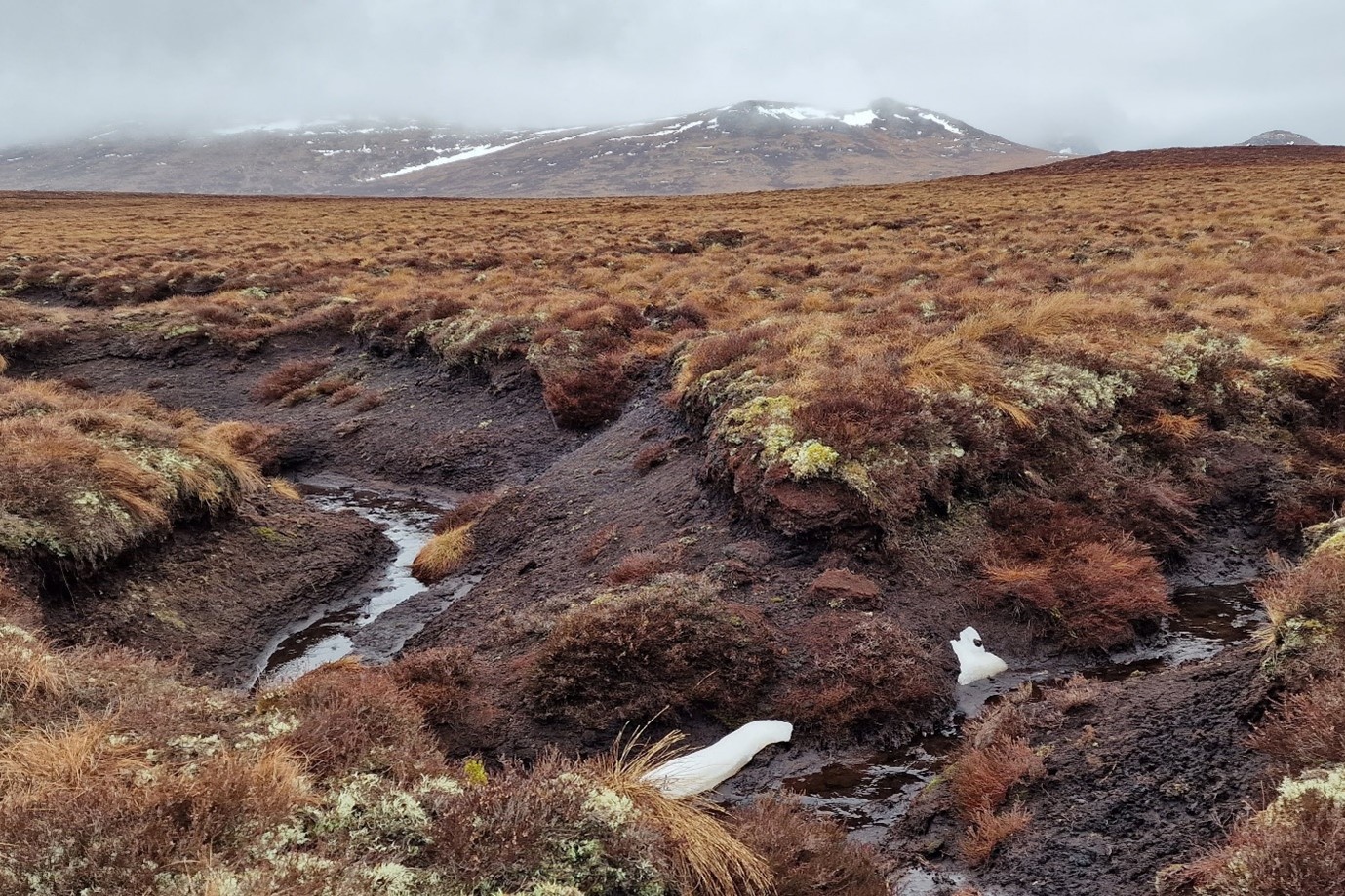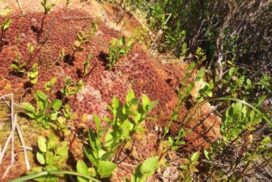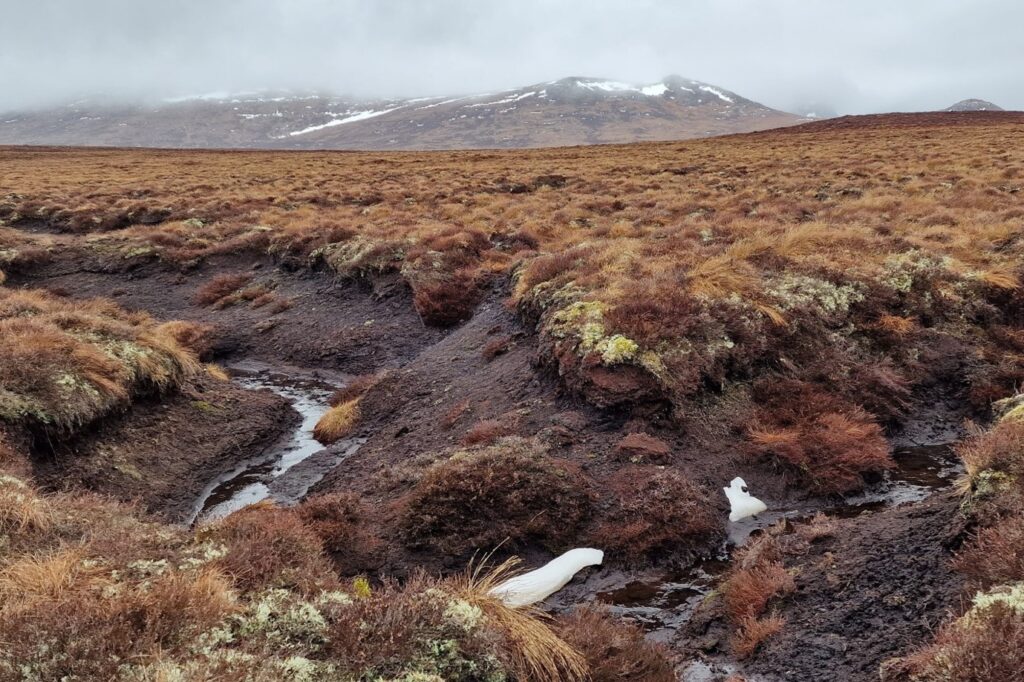The Benefits of Peatland Restoration
1 November 2023Peatlands are defined by the presence of peat soils, which form through the accumulation of decaying organic matter. There are multiple types of peatland in Scotland, raised bogs, usually formed from the continued accumulation of peat over millennia on what was once a lake and blanket bogs, are areas where peat has formed extensively across a landscape over millennia. Over 20% of Scotland’s land area is formed of peatland, although it is estimated that around 80% of that peatland is degraded. Degraded peatlands are a source of GHG emissions, have little biodiversity value and can contribute to flooding, landslides, and decreased water quality. However, these degraded peatlands can be restored to deliver all the ecosystem services that functioning peatlands should provide. To see what is done to restore peatlands read Peatland Restoration Practicalities.
Carbon
Peatlands are unique in their ability to sequester carbon dioxide and a globally significant stores of carbon. This is due to the high-water table of natural functioning peatlands. As the biomass that grows on the peat, usually sphagnum mosses, dies, its litter does not decay quickly due to the high-water table resulting in anoxic conditions. This slow decay is overtaken by the carbon dioxide removed from the atmosphere by the plants on the surface. Essentially, a peatland takes in more carbon than it can breakdown, resulting in the accumulation of carbon in healthy peatlands, resulting in a carbon sink. There are also methane emissions from peatlands, due to the lack of oxygen, but those emissions are lower in a naturally functioning peatland than the equivalent emissions from the accumulated carbon in a degraded peatland.
If a peatland is altered or damaged and subsequently dries out, for example through drainage or tree planting, it stops the process of carbon accumulation and can result in emissions of carbon dioxide as the dried out peat is lost through increased microbial activity in the aerobic peat or through erosion from water or wind resulting in the creation of bare peat areas, haggs and gullies. Although a degraded peatland may never return to its natural state or it could take hundreds of years to do so, restoring peatlands can have a huge impact on reducing the carbon dioxide emissions from the degraded area. Through re-wetting and re-vegetation of peatlands the conditions that result in the loss of carbon dioxide can be reversed and help to eventually return the peatland to become a net carbon sink over time. This is why peatland restoration is becoming an increasingly popular means of reducing emissions from land use at a national and international scale.

Gully erosion on a blanket bog
Biodiversity
The conditions required to form peatland, result in many specialised species surviving and thriving where other species would struggle. The flora of peatlands comprises a carpet of sphagnum moss covering the peat floor, these mosses are not only vital to the water and carbon storage qualities of peatland but provide the foundation layer for all peatland biodiversity. Within Scotland, there are 34 species of sphagnum moss. Some of these can be found all across the country, like the deep red Sphagnum capillifolium and the bright green Spahnum fallx, while others are much rarer, like Shagnum skyense found only in the Isle of Skye and outer Hebrides, and Sphagnum balticum found only in two sites in Scotland, and legally protected within the UK. Upon this carpet of moss grows plants that are only found on peatland habitats, like the Cross leaved heath, Cotton grass, cranberry, bog rosemary, bog asphodel and sundews.

Vegetation of peatlands: Sphagnum capillifolium, hares-tail cotton grass, cranberry. Credit: H. Fisher
These plants and mosses then provide food, microclimates and shelter to specialist invertebrates. Many iconic butterflies and moths, such as the large heath butterfly and the emperor moth require the plants and conditions provided by peatlands. The pools of bog water provide breeding ground and habitat for a plethora of dragonflies and other aquatic invertebrates. While other less known specialist invertebrates, such as the bog sun-jumper spider and the hieroglyphic ladybird are also there, quietly playing their role in this specialised ecosystem. The combination of moss, plant and invertebrates build up to provide habitat and food for some of Scotland’s most iconic birds, mammals, amphibians and reptiles. The pools of water provide habitat for frogs, toads and newts to survive and breed. The structural diversity of vegetation provides microclimates for reptiles like adders and lizards to shelter and warm. These species provide food, and the vegetation provides shelter for birds like snipe, skylark and meadow pipit, which in turn provide food for raptors like hen harrier.

Animals of peatlands: Emperor moth, (credit: H. Fisher),meadow pipit (credit: johndal), hen harrier (credit: Imran Shah).
When peatlands dry out, the specialist moss and vegetation mentioned above is replaced by more generalised grasses and heather species. This in-turn reduces the habitat and food of the specialist invertebrates associated with these plants and mosses. The drying of peatlands removes bog pools, removing habitat for aquatic invertebrates and amphibians reliant on them. These factors mean that specialised birds, mammals and reptiles are reduced or replaced by more generalist species, reducing the overall biodiversity of these habitats. Restoring the habitat can return conditions for our more specialist species and create habitat complexity required to support a rich biodiversity of life.
Water Quality and Quantity
A functioning peatland is a wet peatland. Natural peatlands have a considerable ability to retain water. Similarly, peatlands have an amazing capacity to act as a natural filter and help to remove pollutants from water. Unfortunately, these abilities are significantly reduced once a peatland is drained as it loses its ability to absorb water. Eroded channels within peatland also result in increased water runoff carrying peat sediment into watercourses. These can independently contribute to increased flood risk and a reduction in water quality at times of heavy rainfall impacting on aquatic life but also sources of drinking water. Restoration can play a large role in a peatland regaining its ability to hold back water, helping to reduce flood risks downstream at times of high flow as well as reducing the amount of sediment washed off the peatland and improving the peatland's ability to act as a natural filter for water.

Water reservoir surrounded by peatland
Sarah Erbanova, SAC Consulting
Useful Links
Sign up to the FAS newsletter
Receive updates on news, events and publications from Scotland’s Farm Advisory Service


